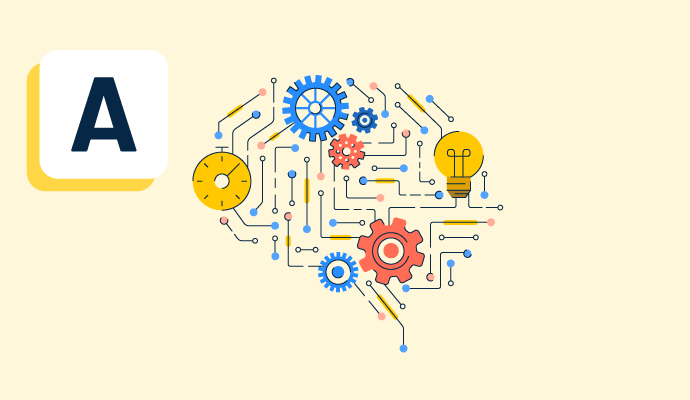What is artificial intelligence?
Artificial intelligence (AI) combines computer science and datasets to simulate human intelligence to perform specific tasks, such as interpreting text and identifying patterns. Examples of AI techniques include machine learning (ML) and deep learning. AI helps reduce the time humans spend on monotonous tasks, and it can help speed up decision making.
Many businesses can benefit from using AI in their business applications and operations. AI and machine learning operationalization (MLOps) software enables companies to monitor machine learning models as they integrate them into their business. These products provide ways to deploy, monitor, measure, and iterate on machine learning models within a company.
Types of artificial intelligence
There are three types of artificial intelligence describing the strength and capabilities of AI. In simple terms, AI is weak, strong, and super. These three types are defined as follows:
- Artificial narrow intelligence (ANI) or weak AI: The most basic and limited type of AI is known as weak AI, even though this type of intelligence is good at performing monotonous tasks. Narrow AI can handle tasks like facial recognition, virtual assistance, or playing a game like chess, as these are limited tasks. It lacks artificial consciousness or cognitive abilities and can’t solve unfamiliar problems. Google Assistant is an example of weak AI.
- Artificial general intelligence (AGI) or strong AI: In theory, AGI can learn, perceive, and comprehend, just like a human being, meaning it can do anything a human can do. Strong AI is not restricted to constraints like weak AI is. AGI requires significant advancements, and at this time, there are no AGI systems currently available on the market. One example of a developing AGI system is a self-driving car, an autonomous vehicle that employs AI.
- Artificial superintelligence (ASI) or super AI: This type of AI is hypothetical and, in theory, would only follow after achieving AGI. Super AI refers to machines that can surpass human intelligence and cognitive abilities. ASI can be controversial as human decision-making and problem-solving would be inferior to this machine’s capabilities.
Basic components of artificial intelligence
Artificial intelligence comprises various components that allow machines to learn enough to interact with the environment around them. The basic components of AI include the following:
- Machine learning (ML) is a branch of artificial intelligence in which a machine learns similarly to the human brain by using algorithms and large amounts of data to draw inferences. ML algorithms continually improve over time with exposure to new datasets.
- Deep learning (DL) is a subfield of machine learning based on artificial neural networks that enable machines to learn by processing data. DL technologies recognize complex patterns to produce highly accurate predictions and solve problems.
- Natural language processing (NLP) is a component of artificial intelligence that allows machines to read and understand human language. It combines machine learning, deep learning, and computational linguistics to process language through text or voice data.
- Artificial neural networks (ANN) are a subset of machine learning models comprising node layers that mimic the human brain’s neural networks.
- Computer vision (CV) is a field of artificial intelligence that strives to enable computers to see and comprehend the world similarly to human beings. Examples of CV tasks include object detection, facial recognition, image classification, and feature matching.
Benefits of artificial intelligence
AI is rapidly evolving the business and technology landscape. When used correctly, businesses may experience many benefits from leveraging AI, including the following:
- Fewer human errors. Even though AI is designed to mimic human behavior, it can reduce human error by using real-time data and examining all possible outcomes to determine the best one. Humans who use AI can better understand their options and the expected results that will follow their decision.
- Automation of monotonous tasks. While AI is not the same as an automation tool, it can help automate repetitive work to save humans time to focus on more complex matters. Tasks like data collection, data entry, invoice generation, and writing email responses can happen in just a few quick clicks.
- Quick decision-making capabilities. Human beings can be indecisive, especially when gathering insights before making a well-informed decision. AI can help people quickly collect reliable and valuable information and use those insights to generate predictions., leading to faster decision making that’s still well informed.
- Digital assistance availability. For businesses, AI can be a massive boon in customer service and experience. AI chatbots can help address simple customer queries by providing timely information on demand.
Artificial intelligence vs. artificial general intelligence
Artificial intelligence is a machine that imitates human intelligence and performs tasks like making decisions and recognizing speech. AI uses machine learning, deep learning, natural language processing, and other technologies to emulate human intelligence.
Artificial general intelligence, or strong AI, refers to a significant advancement in AI technology that society has not yet achieved. AGI would replicate human cognitive abilities and match or surpass human-level intelligence.
Dive into the types of machine learning models to understand how they fit into a business.

Alyssa Towns
Alyssa Towns works in communications and change management and is a freelance writer for G2. She mainly writes SaaS, productivity, and career-adjacent content. In her spare time, Alyssa is either enjoying a new restaurant with her husband, playing with her Bengal cats Yeti and Yowie, adventuring outdoors, or reading a book from her TBR list.

